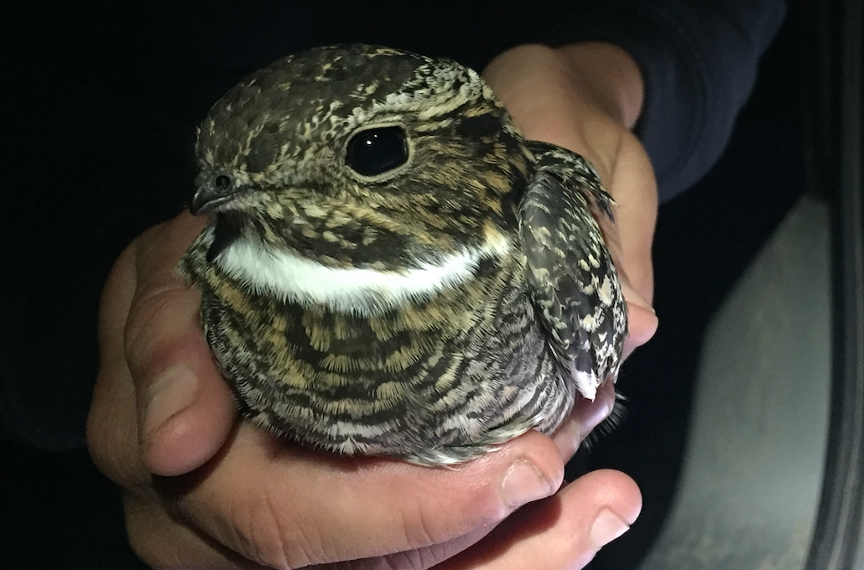
Common Nighthawk Study Update
Block title
Avian Ecology
We seek to understand how birds use the habitats available and how that will change as we work to create more diverse plant communities. We also host researchers that document migrations of raptors and songbirds across MPG.
In this section of the research pages, you will find links to reports and updates from all the researchers involved with avian ecology, posted chronologically. The links will show you more in-depth reports on our findings. The three main projects covered here are:
Songbird Counts- A grid of sampling points covers MPG with 560 points. We visit each point 3 times a year, once in winter and twice during the songbird breeding season. We record, by ear or by sight, all the birds near that point for 10 minutes.
Songbird Banding- The University of Montana Bird Ecology Lab, UMBEL, runs several trapping stations at MPG as part of their regional songbird monitoring program. UMBEL sets up very fine nets that are nearly invisible to birds in brushy habitats. Songbirds fly into the nets and become entangled. The researchers take the birds from the nets and affix a numbered band to their leg before releasing them.
Raptor Research- The Raptor View Research Institute monitors raptor populations on MPG and counts raptors that migrate past MPG in the spring and fall. Raptor View researchers have placed transmitters on osprey and golden eagles that use the Bitterroot Valley.
Common Nighthawks are one of our favorite study species at MPG Ranch. This nocturnal insectivore is common across North America and nests in a variety of habitats. It typically nests in open areas with minimum vegetative cover, such as on gravel beds or rock scree, in rural and urban areas. Like many insectivores, however, the Common Nighthawk has declined across its range. We know very little about the ecology of Montana nighthawks and less about their migratory behavior and winter habitat. Our prior attempts to use typical radio transmitters to track nighthawks proved difficult because birds sometimes traveled and roosted miles from their breeding territories. Tracking them using nanotags and stationary Motus receiving stations has worked great- both on and off MPG Ranch. We are excited to share some of our Motus tracking results with you, which renew our appreciation for nighthawks that breed in western Montana.
Photo: MPG Ranch Common Nighthawk habitat in June 2018.
We embarked on a pilot season in 2019 and tagged three male nighthawks. We did not detect them at any Motus stations during migration or winter. Still, we detected them all back at MPG Ranch the following spring.
We used what we learned in 2019 to increase our captures in 2020, and we tagged 16 additional adults. This tagging success allowed us to make exciting discoveries early in the fall. Motus stations installed by other research projects in the southeast U.S. detected four of these nighthawks.
Map: Early IWC Motus 2020 Fall Migration Common Nighthawk detections.
We anticipated that MPG Ranch’s Common Nighthawks would fly through continental Mexico and Central America instead of the Caribbean Sea, a known flyway of eastern populations. Instead, detections at stations in Missouri and Florida suggest a much more easterly route. Based on these detection dates and locations, we assume that many MPG Ranch nighthawks cross Florida’s Straits in their fall migration. They continue across “who-knows-where” over the Caribbean Sea during the hurricane season. Prior research from Canada and the eastern U.S. indicates Common Nighthawks winter across South America, probably in Brazil or Argentina.
Map: Three Motus projects showing Common Nighthawk estimated pathways from all detections of the IWC Motus Project (yellow), The Common Nighthawk Survivorship in coastal Louisiana Project (green), and the Common Nighthawk/Eastern Whip-poorwill, Noris Lab Project (blue).
We continued to check on Motus detections in late fall and winter. It can take several weeks or months for researchers to check on Motus stations and upload tag detections onto the collective Motus database. As of yesterday, we discovered that one other tagged Common Nighthawk was detected this fall migration in Colombia. This individual left the Bitterroot Valley on September 5th. Fifty-five days later, on October 24th, this nighthawk was picked up for about ten minutes at the Capurganá Motus station in western Colombia, managed by the science and conservation group SELVA. It then vanished, likely as it continued towards its winter grounds further south. This exciting international detection begs the question of how it made it to Colombia. Did it fly over the Caribbean Sea, or instead fly over Mexico and Central America?
The Motus station at Capurganá has detected many Common Nighthawks from another large-scale Motus project in eastern North America (see map below) and is known as a “hot spot” for nighthawks, with multiple birds detected in previous years. SELVA, under the Neotropical Flyway Project (https://neotropicalflyways.com/) actually did nighthawk counts this fall in the nearby village of Sapzurro. Between 29 August and 10 October SELVA team managed to count a season total of 20,071 Common Nighthawks.
Map: Current working Motus stations in Colombia and neighboring countries.
We are currently planning an international Motus expansion project in the isthmus of Tehuantepec, Mexico. This collaborative project will hopefully unravel aspects of Common Nighthawk migration and any neotropical migration research. We are excited to continue updating you with new detections this spring and throughout the year. Many new installations of Motus stations in the next year or two will help us fill existing gaps in the Motus network and will likely produce many more tag detections of Common Nighthawks, so stay tuned!
Relevant Links
Missouri Department of Conservation’s Common Nighthawk Motus detection in Missouri
MPG Ranch Fall 2020 Motus tag update
























